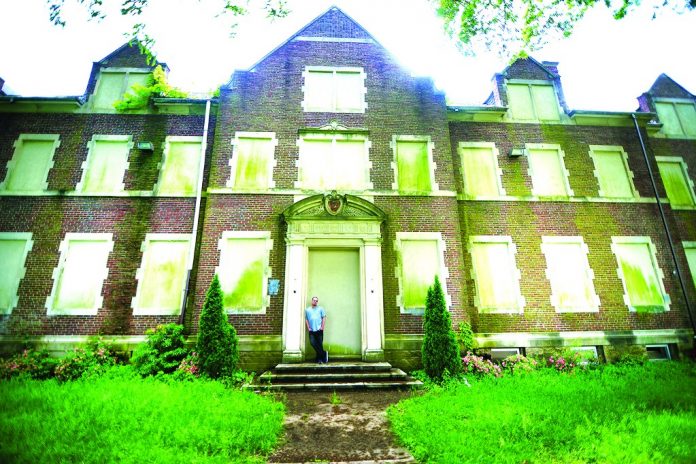Welcome to Byberry: Fox Chase resident John Webster (above) stands outside the nurses’ residence at the former mental institution in Somerton. MARIA POUCHNIKOVA / TIMES PHOTO
Byberry was at first a mischievous lark for Fox Chase resident John Webster, but later it became an obsession. Now, the long-gone Somerton mental hospital is the subject of his first book, The Philadelphia State Hospital at Byberry: A History of Misery and Medicine, which was published by the History Press in mid-May.
For Webster, now 35, it all started in 2002 when he was in his 20s and friends asked him to go exploring in the abandoned asylum’s buildings.
“What remained of Byberry in 2002 was 138 acres of weeds, bushes and large, foreboding buildings, 23 of them … they looked like a scene out of a post-apocalyptic war zone,” Webster wrote in his book’s last chapter.
The closed hospital’s almost forgotten story intrigued him immediately and then became his passion.
“When I first discovered the place, it seemed like a different plane of reality. Like a dream or a weird movie,” Webster told the Northeast Times. “The world slowly faded out of existence as I walked onto the property. Nothing made sense, just hallways and rooms.”
After his first visit, Webster not only regularly explored the old hospital’s buildings during what became weekly trips, he also met other “Byberrians” who he said religiously came to the place.
He had found in Byberry’s easy-to-enter empty buildings a fraternity and a culture specific to the grounds.
“It was a place with no law, no church, no last call and no admittance fee,” he wrote. “Trespassers took full advantage of the ungoverned metropolis. The connecting hallways provide easy passage between all the buildings, and the police rarely attempted to pursue trespassers.”
Teens from nearby Carter Road frequently were in Byberry, Webster said. People didn’t just explore the almost limitless curiosities; they partied in the old empty buildings, he said. They sprayed “copious amounts of graffiti.” They even grew marijuana, he said during a late May interview outside S-10, a nurses’ residence that is one of the structures that remain standing on the south side of Southampton Road.
The years of trespassing, drinking, exploring and mischief started to come to an end for the Byberrians in June 2006 when “the overgrown hospital sign was ceremoniously knocked down” while Gov. Ed Rendell, Mayor John Street and developers looked on.
The hospital had started as Byberry City Farms 100 years prior. In 1926, Webster wrote, the city opened it as the “Philadelphia Hospital for Mental Diseases.” Control was transferred to the state in 1938, and Byberry was renamed again as “Philadelphia State Hospital.”
At one time, the hospital had 56 buildings and 1,100 acres of grounds, he said.
At the peak of state control in the 1950s, he wrote, Byberry housed a maximum of 3,600 patients.
But it once had many more patients.
In the late 1930s, he wrote, when the maximum capacity was only 2,200, “it held a ridiculous 7,000.”
Byberry, which throughout its existence made news because of stories of greed, corruption, negligence, cruelty and criminality, close for good in 1990.
Now, still unfinished homes cover the site north of Southampton Road near the Roosevelt Boulevard, Webster wrote in his book’s concluding pages, “but portions of the hospital’s roadway system are still in place.”
Webster said he collected many Byberry artifacts over the years as well as information. While trolling the Internet, he found a photo of a cornerstone being dedicated. Soon after, he found that cornerstone.
“I smashed it open and I got a lot of goodies out of it … aerial photographs, a copy of the hospital’s news letter. … That stuff would have gone to a trash heap.”
Webster’s research was followed by creation of his own website, www.PhiladelphiaStateHospital.com, in 2003. He began work on his book last summer.
He said he didn’t talk to any historians specifically for the book, but since he launched his website in 2003, he said, he’s conferred with many.
“I had been interrogating people about it for about 10 years,” he said.
Webster tells the hospital’s 100-year story in a brisk, easy-to-read style, and the book is illustrated with 75 photographs from the Historical Society of Pennsylvania, Temple University Urban Archives, the Pennsylvania State Archives, the Athenaeum of Philadelphia, PhillyHistory.org and friends. Some images, he said, he photographed himself.
“I knew from the beginning how I wanted to lay it out,” Webster said of his book. “There’s everything from politics to architecture to horrific tragedy to heroic bravery and selfless sacrifice in there.”
His impression of Byberry changed as he wrote.
“When I began work on the book, I thought I had a pretty clear impression of the place, but some other points of interest sprang up in the process, and, after tracking down answers … my opinion changed slightly again, for the better,” Webster wrote in an email to the Northeast Times. “I learned there were caring people there, in fact, heroes, and their stories were seldom heard.”
Webster’s obsession with the hospital’s history developed in him a wider interest.
I’m very passionate about history and have — within the last 10 years — come to know a profound respect for Philadelphia’s history, and with it, American history.” ••
Meet the author
John Webster will be at Barnes & Noble Plymouth Meeting, 2300 Chemical Road, Plymouth Meeting, at noon on July 13.





